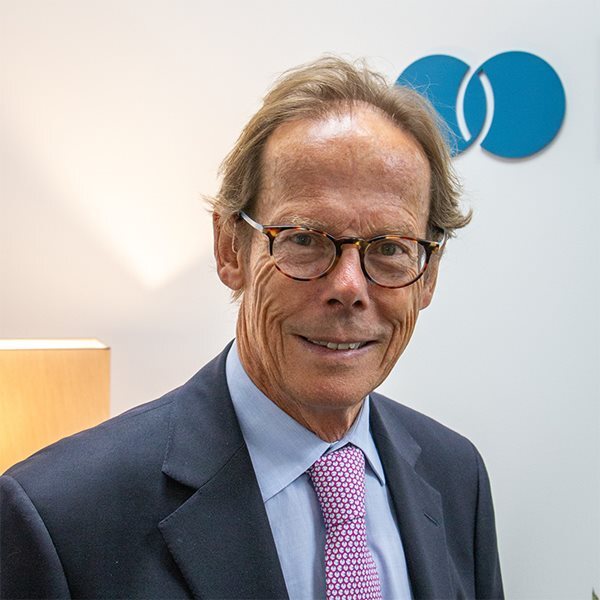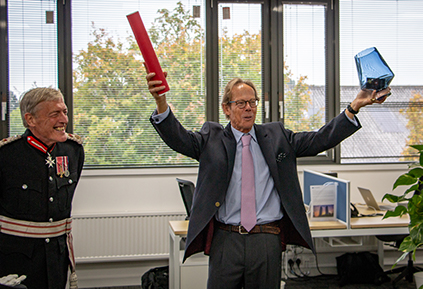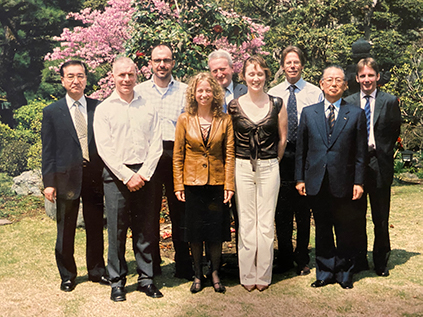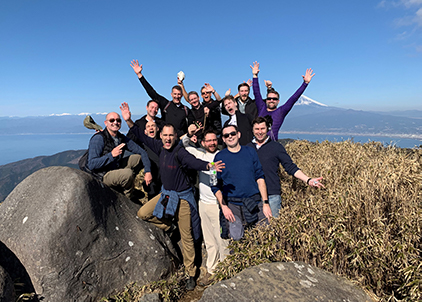A week after our 30th anniversary seemed a good time to fire some questions at our Founder & Chairman, James Lawson (second left above in the 1990s; below today), to see what he had to say about his memories and experiences over the last three decades.
Looking back over your last 30 years in business, what are your most memorable moments?
In month four after setting up Intralink, through a combination of unlikely coincidences, a Japanese company asked for my help and offered to pay a monthly retainer that covered our running costs. It was an amazing leap of faith on their part and a wonderful ‘underpin’ for me.
Reaching a turnover of £1 million in 2000 was a huge moment. After all the hard work, the business had become sustainable and there would be no turning back.
The three-year ‘stay with us’ deal I agreed with Greg Sutch in 1998 in a bar at Tokyo’s Prince Takanawa Hotel turned out to be a pivotal decision. At the time, he was being romanced by another company, and today, 22 years later, he’s our CEO, the largest shareholder and the architect of our last six years’ continuous growth.
I remember the look of total relief on my wife’s face when I paid off the mortgage! She’d worked in the business but had made it clear the house was not to be part of it.
I also recall a late-night session in the southern Chinese village of Lijiang during a team outing in 2010, when the senior team and I agreed a value for the company for the management buy-out. It took something like 15 months of meetings with lawyers, advisors and banks, but we never argued, wavered nor sought a third-party valuation – which appeared to be a first for our advisors!
More recently, winning the Queen’s Award for Enterprise in 2018 was an amazing milestone.
Receiving the Queen's Award for Enterprise
Do you have any regrets?
Well, it would have been special if my son had joined the business.
Many people have asked if I regret not having struck out on my own much earlier, but I don’t think it would have worked. It was partly the accumulation of experience but mostly that I would never have taken the plunge if I hadn’t been out of work and in free fall with three kids and a mortgage!!
It’s not really a regret, but there were many nights over the first five years when I woke in a cold sweat thinking about our debtors, where the next piece of business would come from and whether I could cover the next grocery bill!
Did you start with a plan?
No! I was out of work and desperate. I had a background working in Asia – Japan in particular – so there was a logic in trying to monetise that experience. But that was easier said than done!
The catalyst wasn’t a plan but a £1,000 bet that I could find 10 new products in Japan for a business contact I’d met.
I’d written dozens of business plans which were generally over-optimistic but a necessary evil if you had to go to the board or the bank. For a startup, the only thing that really counted was whether enough people would buy what you were selling and if the money coming in was more than the money going out. It was a matter of how long you could survive.
The question of what I was selling was rather more difficult. It was a consultancy service but, in practice, it was about delivering a result for the client. I’d had some early breaks, but the problem was finding the right balance between securing clients in the UK and delivering results in Japan. Also, since I’m a team person, how then to scale the business?
I should add that, as far as the lack of a business plan was concerned, apart from securing a £10k credit line when I first opened the account, I didn’t visit the bank again until the management buy-out 21 years later.
Have you ever thought about selling the business?
We’ve been approached a few times and also looked at acquiring or partnering. India always seemed a market that might respond well to our model, but at the same time we’ve been growing consistently in East Asia and believe we’re still only scratching the surface of the potential in these markets.
What about memorable clients?
Over the last three decades, we’ve had more than 800 clients across an astonishing range of industries.
In the early days, we’d work for almost anyone. A few interesting examples include non-lubricated bearings, jewellery, ladies’ hosiery, even property investment. We were working for some amazing companies but, when Alan Mockridge joined in 2000, we began to focus on technology.
Intralink and Atsugi, a ladies' hosiery manufacturer c.1997
I remember meeting KAL, a middleware software company targeting Japanese ATM manufacturers. They’d been pushing away in Japan for 12 months with no progress. Middleware sounded like a range of sports clothing to me – but they took us on, nonetheless.
KAL were followed by DivX Networks, who were frustrated by a lack of progress licensing their technology to TV and camera manufacturers in Japan. At that point, we didn’t really understand the technology, but we were good at securing deals. The key was to let the R&D teams talk to each other but ensure we had relationships at the right level in the commercial departments.
DivX went on to IPO in the States for $145 million, so our Surrogate Sales model had proven itself and we had some serious street cred in the tech world as a result. That was followed by another important success with Ubiquisys, whose mobile network cell technology was adopted by Softbank in Japan, paving the way for Ubiquisys to sell its business to Cisco for $300 million.
We were rapidly gaining tech sector expertise to go with our market access and sales strengths. Now, twenty-something years later, we have specialist practices in medtech, environmental technology, automotive, digital media, software, telecoms and more.
Any scary moments stand out?
Ironically, just as jewellery maker Cabouchon was a breakthrough client in terms of business income, it was also almost our downfall. We over-extended, failed to keep the hopper full of prospects and left our other clients unloved.
I also remember the first visit from an HMRC Compliance Officer who discovered several thousand pounds of under-paid tax as result of some incorrectly allocated costs. I was an unintentional criminal and recall my father saying that a stain was worse than death! It was a mistake we would never make again.
Any funny meetings?
The first relates to a client with a novel treatment for varicose veins. One of our team was tasked with determining how the ailment was treated in local Chinese hospitals. Early attempts to meet doctors had been met with rejection, cardiovascular surgeons telling us they were prohibited from talking to drug manufacturers because of legislation against kickbacks.
Visiting a small local hospital in south Shanghai, our team member decided to take a different approach and made up a touching story about his mother’s severe varicose veins. He walked straight into the hospital’s varicose vein ward and was greeted by two doctors and a few nurses. He told his story and, impressed by his dedication to his poor mother, they were more than willing to explain the treatments available and let him watch them perform a therapy session.
The approach worked just as well in other hospitals and so, with a bit of creative storytelling, we were able to get a great deal of the information necessary for the client report.
The second relates to a member of our team in Japan who’d arranged for our client to speak at an exclusive toxicology conference 900 km southwest of Tokyo near Ibusuki. Ibusuki is well known for its hot sand baths and he and the client decided to take a side trip after the conference to experience them.
At the station, they chanced upon an eminent toxicologist working for a major Japanese pharma corporation who was also making his way there. Over the next two hours, we ensured our client and his important prospective customer were comfortably buried side-by-side up to their necks in warm volcanic sand – with an order duly placed some weeks later.
What’s been your approach to hiring the right people?
Ours is clearly a people business. When we set out, one of our differentiators was the fact we predominately employed overseas nationals who were passionate about the country in which they operated, spoke the local language fluently and could act as a bridge between cultures. That has changed, and now we employ many more Asian nationals who speak fluent English, have spent time in Europe or the US and so understand western culture and ways of doing business.
We’ve always looked for people with great social skills and attitude. Social skills are important as so much work is undertaken over dinner and drinks after office hours when you unpick the nuances of the day’s meetings but also talk about everything else under the sun! We have a terrific team spirit, a high quotient of job satisfaction and low staff churn.
How would you sum up the keys to success over the last 30 years?
We’ve developed a business model that’s versatile and robust; we work in markets that are lucrative and dynamic; we have few direct competitors; our systems and structures have allowed us to grow organically; we’re focused on technology that, post-COVID-19, has even greater market potential; and we have a passionate and experienced management team – and a great set of employees.
Intralink management trip to Mount Fuji
What advice would you give to other entrepreneurs?
It’s vital to listen and reflect but also to be brave and decisive; to keep a sense of humour at all times; to have another passion and take your holidays; to hire smart people with plenty of attitude; and, most importantly of all, never to give up!
See also:






